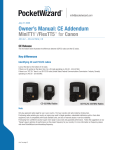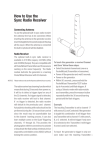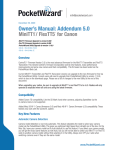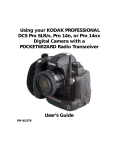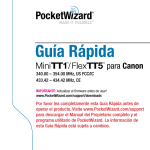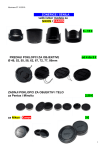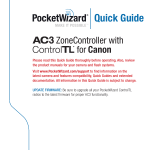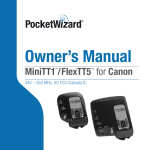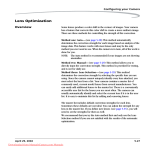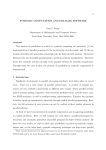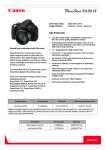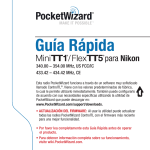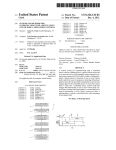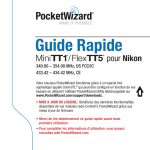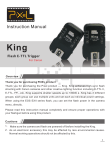Download Owner`s Manual: Addendum
Transcript
[email protected] April 2, 2009 Owner’s Manual: Addendum MiniTT1™/FlexTT5™ for Canon 340 - 354 MHz, US FCC/ Canada IC MiniTT1 Firmware Upgrade to version 4.100 FlexTT5 Firmware Upgrade to version 4.100 PocketWizard Utility Upgrade to version 1.18 New Features Remote Manual Mode for Canon Speedlites This mode allows you to remotely control the manual settings of Canon Speedlites. Canon calls this mode “Setting the Flash Output for Each Slave” or “Wireless Manual Flash with Varied Flash Output.” This mode works with the 580EX II on the top shoe of a ControlTL transmitter. It does not work with the original 580EX. Only the 580EX II has the command codes to use Remote Manual Mode via the hot shoe. With a 580EX II on the top shoe of the transmitter, engage manual + Master mode normally: 1.Press MODE until M appears. 2.Engage MASTER by pressing and holding ZOOM for 2 seconds. When “OFF” blinks, spin the select dial until MASTER appears and press SET. 3.You can now use the manual controls of the 580EX II to set the manual flash level of your remote Speedlites. To manually control more than one “zone” of light, you need to select RATIO mode by pressing ZOOM until RATIO blinks, then spin the wheel until either A:B or A:B:C blinks and press SET. Set the remote FlexTT5-mounted Speedlites to normal mode (not SLAVE or MASTER, just ETTL), and select the slave group using the FlexTT5 ABC switch. You may have as many flashes in each group (A, B & C) as you would like. On the MASTER flash, use the select dial and SET to choose the slave group and set the manual remote flash value. See Page 45 of the Canon 580EX II User Manual for more information. This mode expands Canon’s system. Normally when using Canon’s optical system, and not using Ratio A:B or A:B:C mode, all 3 slave groups would be triggered. This can be undesirable because you might want to have flashes on groups B or C not trigger for some photos, but trigger for others. Via ControlTL, you have more control over which slave groups are triggered while still utilizing Canon’s controls on the 580EX II intuitively: • If you have no slave groups selected (you are not using Ratio A:B or A:B:C) then only slave group A will trigger. Remote FlexTT5 units set to B or C will not trigger but will be available for you to include them in other photos if you choose Ratio mode A:B or A:B:C. •If you have Ratio A:B selected then only A and B will trigger. C will not. •If you have Ratio A:B:C selected than all three slave groups will trigger. NOTE: A lot of information moves around for remote manual mode to function. Whenever possible, make sure to hold the shutter release of your camera half-pressed for a moment to allow all of the data to transmit. You must remove the 580EX II from the shoe of the FlexTT5 before enabling MASTER mode. 1 [email protected] Canon 550EX, 420EX, and 220EX compatibility These older Canon flashes can be used as follows: 550EX: Can be used on the FlexTT5 as a receiver in either ETTL mode or Manual mode Can be used on the FlexTT5 as a transmitter, but only in Manual mode Cannot be used on a MiniTT1 in Manual or ETTL mode, or FlexTT5 as a transmitter in ETTL mode 420EX: Can be used on the FlexTT5 (transmitter or receiver) in ETTL mode Cannot be used on the MiniTT1 220EX: Can be used on the FlexTT5 as a receiver in ETTL mode only Cannot be used as a remote flash in Manual mode Cannot be used on a MiniTT1 or FlexTT5 as a transmitter SPECIAL NOTE: This flash performs better if an OC-E3 cable is used. Automatic HSS Trigger Timing for Manual Flash If you are using 1/640 or faster shutter speeds, then a remote manual flash connected to a FlexTT5 will trigger at the same moment as a Speedlite performing HSS/FP Sync begins emitting light. If the manual flash has a long enough flash duration, it may provide usable flash in the exposure all the way up through 1/8000 shutter speed. This mode, which happens automatically, is for combining Speedlites in HSS mode and manual flash simultaneously. You cannot control the trigger timing as you can with HyperSync. If you want to control the timing of the trigger for an all-manual flash system, and achieve better uniformity of lighting across the image at faster shutter speeds, then you need to use HyperSync and High Speed Sync (FP Flash Sync) Disable Mode (see below). SPECIAL NOTES • As you increase shutter speeds and the camera is exposing the frame with a moving slit, you might get gradations across the frame in either brightness or color depending on your manual flash unit’s light output profile. You may also get black bars. It may not be possible to eliminate these conditions for your camera and flash combination, but for more control of the situation, consider using HyperSync exclusively instead of HSS Trigger Timing. • This feature only works with a FlexTT5 as a receiver. It will not work with a Plus, MultiMAX, or other PocketWizard radio as a receiver. To achieve faster shutter speeds with these radios use HyperSync. • There must either be no flash in the top shoe of the ControlTL transmitter, or that flash must have HSS enabled, for shutter speeds higher than X-sync to be available. • It is safe to use a flash in the top shoe of a FlexTT5 (manual or E-TTL II) and have a manual flash connected to P2 simultaneously. They will trigger at the same time. The manual flash connected to P2 will not perform E-TTL functions. Auto Trigger Select for ControlTL™ The top hot shoe on both the MiniTT1 and FlexTT5 will now trigger a Speedlite in either manual or E-TTL II mode automatically. This will also work with manual hot shoe flashes like the Vivitar 285HV, or any flash connected via P2. You no longer have to specify receiving on a Standard Channel on a FlexTT5 when using a manual flash. You can leave the FlexTT5 in its default “Use ControlTL for Rx Channel” mode. Caution! Make sure your hot shoe flash has a sync trigger voltage of less than 50 volts. Higher voltage hot shoe flashes may not trigger and may damage the PocketWizard radio’s circuitry. The P2 port can handle up to 200 volts. NOTE: It is safe to use a flash in the top shoe of a FlexTT5 (manual or E-TTL II) and have a manual flash connected to P2 simultaneously. They will trigger at the same time. The manual flash connected to P2 will not perform E-TTL functions. 2 [email protected] Continuous Remote Camera Triggering (FlexTT5 only) This feature allows for triggering a continuous motor drive burst of a camera connected to P1 on a remote FlexTT5. You can use most PocketWizard transmitters (Sekonic meters excluded) – just press and hold TEST on the transmitting unit to have the remote camera, set for continuous shooting, trigger for as long as you hold TEST. SPECIAL NOTES • The FlexTT5 must have at least one of the following conditions met for this feature to function properly: - Mount the FlexTT5 off the shoe of the remote camera. - Have Bottom Shoe Disable mode selected. - Use Basic Trigger Mode. • It is not possible to combine continuous remote motor drive operation with ETTL operation on the remote camera. • If Auto-Relay Mode for E-TTL II operation is required, then it will only function in single shot mode. 3 [email protected] New Features Available via the PocketWizard Utility Basic Trigger Mode - Found under Misc Tab Allows the MiniTT1 or FlexTT5 to operate as a basic PocketWizard radio slave on any camera it will fit, including cameras other than the Canon models the radio is designed for. This mode only uses the center hot shoe contact for sync input. It does not use any of the E-TTL II communication pins. Caution! If you are using a compatible Canon camera it is highly recommended that you do not enable this option. Caution! Due to the Canon-specific layout of the pins on the bottom shoe, the MiniTT1 and FlexTT5 are not guaranteed to slide onto every camera’s hot shoe. Do not force the units onto your camera. Slide gently. SPECIAL NOTES • It is not necessary to set receiving FlexTT5 radios into this mode to match your MiniTT1 or FlexTT5 transmitting unit. The receiving FlexTT5 just needs to be set to receive on a Standard Channel. The only time you would need to set a remote FlexTT5 to Basic Trigger Mode is if you are deploying it to trigger a remote non-Canon camera in Auto-Relay Mode. • In this mode you get basic remote triggering on PocketWizard Standard Channels. This works with all PocketWizard radios including the Plus, MultiMAX, and devices with PocketWizard radios built-in. • HyperSync, High Speed Sync (FP Flash), or ControlTL (E-TTL II) are not available when using this mode. • Battery life on the MiniTT1 will be less than when working on an E-TTL II camera with this mode disabled. Normally the MiniTT1 sleeps when the camera sleeps based on data it receives from the camera on the E-TTL communication pins. Since those pins are deactivated in this mode, the MiniTT1 never sleeps. Expected battery life is 100+ hours. FlexTT5 battery life will remain unchanged at ~60 hours. • The fastest usable shutter speed for flash (X-Sync) may be affected. This mode takes ~900 microseconds (1/1111 of a second) from the time X-sync is received until the remote flash begins generating light (radio propagation delay). Some cameras and flash combinations will tolerate this delay and achieve X-sync normally. Some will not. On those cameras you may need to reduce your shutter speed to something slower than X-sync to eliminate black lines in your images. Shortening your flash duration may also help. • A hot shoe flash or Speedlite in the top shoe of a radio in this mode will only trigger in manual mode. Transmitter Only Mode (FlexTT5 Only) - Found under Misc Tab Allows the FlexTT5 to be used as a Transmitter only just like the MiniTT1. This mode allows a photographer to work in the same area as other photographers, and share remote flashes, without the flash on top of the FlexTT5 being triggered by the other photographers. When this mode is engaged, the FlexTT5 will not respond to any triggers from another MiniTT1 or FlexTT5 acting as a Transmitter. High Speed Sync (FP Flash Sync) Disable Mode - Found under Sync Timing Tab This new mode allows you to select *either* High Speed Sync (HSS or FP Flash) from 1/640 through 1/8000 *or* HyperSync from 1/640 through 1/8000. HyperSync will still operate from 1/250 through 1/500. Default is to have this box unchecked to allow seamless operation of HSS. Normally, the MiniTT1 or FlexTT5 uses HyperSync from 1/250 - 1/500, then switches to HSS at 1/640. When HSS/FP is automatically engaged in this fashion, Standard Channel triggers are disabled at 1/640 and higher shutter speeds. When using this feature, HSS/FP is never engaged and Standard Channel triggers are used throughout the entire range of shutter speeds by using HyperSync per this table: 1/200 and slower HyperSync not used 1/250 through 1/350 Auto-calculated HyperSync offset used 1/400 through 1/8000 Full HyperSync offset used 4 [email protected] This allows you to have a remote manual flash trigger at any shutter speed and control trigger timing using the HyperSync Offset. This works with the FlexTT5 as a receiver, or any other PocketWizard receiver including the Plus, MultiMAX, and flashes with PocketWizard radios built-in. This mode enables your camera to trigger a flash at any shutter speed, but it does not guarantee that your camera and flash combination will achieve proper sync at every shutter speed and flash duration. You will need to experiment with different HyperSync Offset values and different flash duration settings on your flash (longer is often better at faster shutter speeds) to achieve usable results. As you increase shutter speeds and the camera is exposing the frame with a moving slit, you might get gradations across the frame in either brightness or color depending on your flash unit’s light output profile. You may also get black bars, an indication that flash duration is too short or your HyperSync Value is too extreme. It may not be possible to eliminate these conditions for your camera and flash combination. SPECIAL NOTES • It is not possible to combine HyperSync and HSS triggers. • To turn off HyperSync and use standard trigger timing, set the HyperSync Offset to 0 (zero). • Currently there is not a method for forcing HSS to work from 1/250 through 1/500 instead of HyperSync. This means that with some camera and flash combinations you may not be able to achieve perfect sync at 1/400 or 1/500 when using ControlTL radios. Black lines may still appear and may not be able to be eliminated using HyperSync. A future firmware upgrade will include a mode that allows for HSS operation to be selected for all shutter speeds from X-sync on up. • If you place a Speedlite in the shoe of a MiniTT1 or FlexTT5 on the camera, and the radio has High Speed Sync (FP Flash Sync) Disable Mode checked (not recommended), you should be aware of the following behaviors: -If that Speedlite also has HSS disabled, then you will not be able to set your camera shutter speed higher than X-sync. -If that Speedlite has HSS enabled, then it will allow the camera to be set to all shutter speeds. The Speedlite will attempt to perform normal E-TTL II triggers (in ETTL mode, not HSS mode) but may not be able to provide proper sync as you increase shutter speeds. Other Features A new connection confirmation feature has been added. As you turn on a Speedlite in the shoe of the FlexTT5 it will trigger a very low output flash to confirm that it has made good data connection with the FlexTT5. As always, it is best to turn on the MiniTT1 or FlexTT5 before the rest of your equipment. 5 [email protected] Bug Fixes: • 430EX issues: The original 430EX (I, not II) would sometimes cause over-exposures or “blowouts” when used as a remote flash on a FlexTT5. Operation appeared erratic. This has been corrected. NOTE: The 430EX is still a very RF noisy flash and every effort should be made to optimize reception. Please use the mounting suggestions on Page 30 of the Owner’s Manual, and especially consider using a Canon OC-E3 cable and a ferrite choke. • 580EX (I and II) Custom Functions: Fixed issue where certain Custom Functions or C.Fn combos caused a remote flash to not trigger. • Shutter speed raising then lowering: Previously if you started at a shutter speed faster than 1/500, then went back down below 1/250 in one step, remote flashes could get out of sync (shutter speeds between 1/250 and 1/500 were not affected). If the camera went to sleep and woke back up, this usually cleared the problem. On fast sleeping cameras like the 40D, 50D, Rebel, etc., this issue hardly ever manifested. On cameras that took longer to sleep, like the 1D Mark III, the impact could be larger. This has been corrected. • Relay Mode: Fixed issues around Auto-Relay Mode in the FlexTT5 where it would not perform properly when triggered from a Standard Channel Transmitter. Also corrected situation where a flash in the top shoe of the FlexTT5 might not trigger in relay mode. Corrected a “lock-up” situation. • FlexTT5 P2 trigger as transmitter: Previously the FlexTT5 was not triggering P2 when it was being used as a Transmitter. This would have made a local manual flash connected to that port not usable at the camera position. This has been corrected. • FlexTT5 TEST response time: When TEST was pressed on a FlexTT5, it could take up to a full second before the connected or remote radios were triggered. This has been corrected. • 1Ds Mark III wakeup: In some instances the 1Ds Mark III (and possibly other cameras) when coming out of sleep mode, would cause odd behavior with the ControlTL radios. This has been corrected. • Shutter speed limiting: On the 1D Mark III and 5D Mark II, and possibly some other cameras, sometimes shutter speed would bounce down to X-sync. This has been corrected. 6 [email protected] Not included in this release: • 1D Mark II and ratio mode: On this camera, the ratios can seem to be erratic or take more than 1 shot to achieve proper settings. Sometimes an over-exposure or “blowout” occurs. • 5D Mark II with a flash on the top shoe of a MiniTT1 or FlexTT5 as transmitter in E-TTL II mode. It will do HyperSync, standard triggering, manual flash in the shoe, and even basic remote E-TTL II. The one thing it cannot currently do with our ControlTL system is have a Speedlite or ST-E2 in the top shoe of the MiniTT1 or FlexTT5 when used as a transmitter on the camera. This camera came out late in our development cycle, and is very different from all previous cameras. We are reviewing solutions to get this last piece working. • FEC control from the flash is not implemented. FEC from the camera works, but some photographers prefer to use the flash FEC control due to familiarity and simplicity, as well as the ability to achieve +/- 3 stops versus some camera’s +/- 2 stops. • Other features not expressly covered like Rear Curtain Sync, FEB, stroboscopic, remote DOFP and modeling mode, and adjusting flash settings or custom functions via the camera’s controls are not implemented. • Distance info on 580EX II not updating sometimes. • Other flash manufacturer’s flashes. Quantum, Metz, Sunpak, etc. compatibility is not confirmed. • Custom IDs not yet available. © 2009 LPA Design, Inc. All rights reserved. Product features and specifications are subject to change without notice. PocketWizard, ControlTL, MiniTT1, FlexTT5, HyperSync, Plus II and MultiMAX are either trademarks or registered trademarks of LPA Design, Inc. All other trademarks contained herein are the property of their respective owners. This product is covered under a warranty. For more information on this warranty and to register your product, please go to www.PocketWizard.com/support. US Patent: 5,359,375 and Patents Pending www.PocketWizard.com 7







